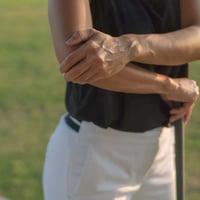Shoulder pain can significantly impact your daily life, affecting mobility and overall well-being....
Tennis Elbow: Causes, Symptoms, & Recovery Tips

Tennis elbow, or lateral epicondylitis, is a common overuse injury that affects the tendons in the forearm. While it’s often associated with tennis players, anyone who engages in repetitive wrist and arm movements—such as office workers, carpenters, and musicians—can develop this painful condition.
If left untreated, tennis elbow can interfere with daily activities and reduce grip strength. Fortunately, with the right treatment approach, including physical therapy, many individuals recover fully. Read on to learn about the causes, symptoms, and expert-backed strategies to manage tennis elbow effectively.
What Is Tennis Elbow?
Tennis elbow is a form of tendinitis that occurs when the tendons in the elbow become inflamed due to repetitive stress. The condition primarily affects the extensor carpi radialis brevis (ECRB) tendon, which helps stabilize the wrist and is involved in gripping motions.
Despite its name, most cases of tennis elbow occur in people who don’t play tennis. Any activity that involves repetitive wrist extension—like typing, painting, or lifting—can strain the tendons and lead to inflammation.
For a more detailed explanation, check out Mayo Clinic’s guide on tennis elbow.
Symptoms of Tennis Elbow
Tennis elbow symptoms usually develop gradually and worsen over time. Common signs include:
- Pain and burning on the outer part of the elbow
- Weak grip strength, making it difficult to hold objects or shake hands
- Pain that worsens with wrist and hand movements, such as typing or lifting a cup
- Tenderness to the touch along the forearm
- Stiffness in the elbow, particularly in the morning
Symptoms are often aggravated by activities that require wrist extension or gripping. If left untreated, pain can become persistent and impact daily function.
How Can Physical Therapy Help?
Seeking physical therapy near you can be one of the most effective ways to recover from tennis elbow. A physical therapist in NYC or your local PT clinic near you can help with:
- Manual therapy: Hands-on techniques can improve blood flow, reduce muscle tightness, and promote healing.
- Eccentric strengthening exercises: These controlled movements help repair damaged tendons and prevent future injury.
- Stretching routines: Gentle stretches reduce stiffness and improve forearm flexibility.
- Bracing or taping: A physical therapist in Brooklyn or your nearest clinic may recommend a brace to relieve pressure on the affected tendon.
- Ergonomic and activity modifications: Small changes in wrist positioning or grip technique can prevent symptom recurrence.
Lifestyle and Self-Care Tips for Managing Tennis Elbow
While professional treatment is crucial, adopting certain lifestyle changes can help accelerate recovery and prevent future flare-ups.
1. Rest and Activity Modification
Reducing activities that aggravate symptoms is essential. If repetitive wrist movements are unavoidable, using an ergonomic grip or alternating hands can help prevent strain.
2. Ice Therapy
Applying ice packs for 15–20 minutes several times a day can reduce inflammation and numb pain.
3. Stretching and Strengthening Exercises
Regular stretching and strengthening exercises can improve tendon resilience. A physical therapist in Manhattan can design a program tailored to your specific needs.
4. Proper Equipment Use
For athletes and manual workers, using equipment with the right grip size and weight distribution can minimize tendon stress.
5. Gradual Return to Activity
Avoid rushing back into repetitive activities. A gradual increase in intensity allows tendons to rebuild strength safely.
When to See a Doctor or Physical Therapist
If your symptoms persist for more than a few weeks despite rest and home treatment, it may be time to consult a specialist. A doctor can assess the severity of your condition and recommend interventions like corticosteroid injections or platelet-rich plasma (PRP) therapy.
A physical therapy place near you can also provide structured rehabilitation programs to enhance recovery and prevent recurrence.
Final Thoughts
Tennis elbow can be a frustrating condition, but with early intervention and the right treatment plan from a physical therapist in NYC on MotionSync—you can regain function and prevent chronic pain. If you’re looking for expert guidance, consider visiting a physical therapist or your nearest PT clinic for a customized approach to healing by finding the right PT for you now on MotionSync.




